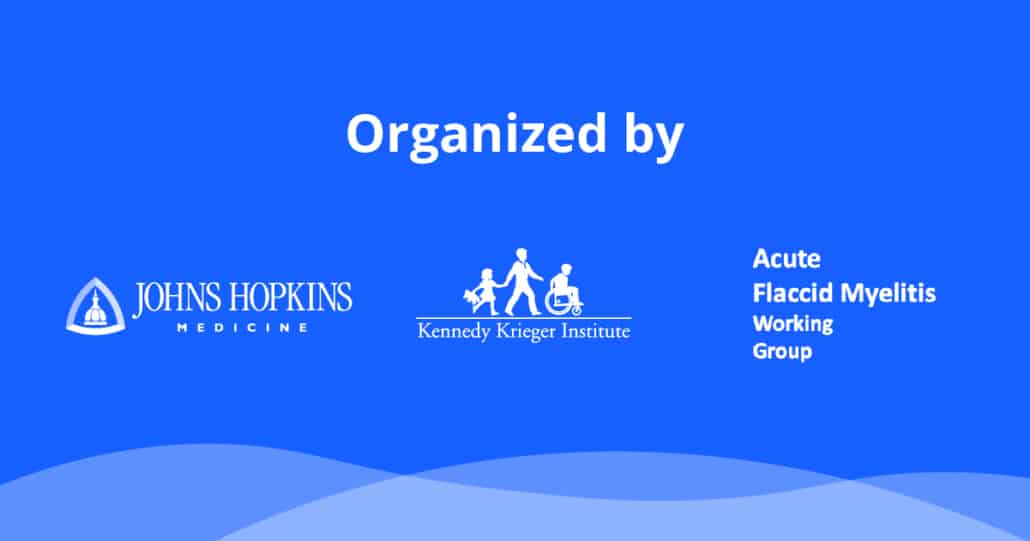A Recap of the 2020 AFM Virtual Symposium Parts I, II, and III
The Acute Flaccid Myelitis Working Group, Johns Hopkins Medicine, and Kennedy Krieger Institute organized a virtual symposium, Acute Flaccid Myelitis: What we have learned in order to be prepared.
AFM Awareness Month will kick off with the last session of this virtual AFM Symposium on Friday, July 10, 2020. If you haven’t attended these symposia sessions, we encourage you to sign up for the last session and review the past sessions located on our website. Take some time to review the information and perhaps learn more about your own diagnosis and the importance of advocating for yourself.
The first three parts of the symposium have covered a breadth of topics on AFM diagnosis and acute management, critical care management and understanding pathogenesis, viruses and immunity. We summarize and highlight some of the key lessons we have learned from leaders in the community who have dedicated their careers to understanding AFM and helping families and children. Over 300 people registered for this symposium. All sessions were recorded and are available on our website here.
Dr. Kevin Messacar from Children’s Hospital Colorado commenced the first session and offered an overview of our current understanding of AFM. He was followed by Rachel Scott, co-founder of the Acute Flaccid Myelitis Association (AFMA), who shared her powerful story and experience with her son Braden’s AFM diagnosis, who was diagnosed in July 2016. Dr. Janell Routh from CDC shared that the last six years of surveillance data have showed us that although we have a consistent low baseline level of AFM cases every year, something definitely changed in 2014 and we started seeing a peak of AFM cases every 2 years, mostly during late summer/early fall. This change seems to be related to the circulation of enterovirus-D68 (EV-D68). Dr. Charles Chiu at University of California San Francisco spoke about the connection between AFM and EV-D68 and EV-A71, which are viruses that were identified from respiratory secretions prior to the onset of the weakness from samples of children diagnosed with AFM. He reminded us that diagnosis in AFM is challenging, especially if we want to be able to identify the viruses in blood or other samples, as most of the time we are not able to find it in these samples. He also reminded us of the importance of creating and investing in new methods of diagnosis that are faster and more accurate. Then, the impact of social distancing measures of the COVID-19 pandemic on AFM was discussed by Dr. Bryan Grenfell and Daniel Park. It will likely delay and perhaps even increase the susceptibility of the population to the virus, with the possibility of a larger outbreak in the future.
Drs. Elizabeth Wells, Sarah Hopkins, and Leslie Benson all reiterated for pediatricians and emergency room (ER) doctors across the country to think about AFM when they see a child with weakness and emphasized for parents that if a child starts to develop any type of weakness to seek help at a major hospital ER immediately, even with the fear of the COVID pandemic. Abnormalities in the images of the spinal cord in AFM are sometimes very subtle, especially in the early phase, which could pose a challenge in getting a diagnosis. Dr. Olwen Murphy from Johns Hopkins University discussed research findings and enumerated what to look for radiologically when making a diagnosis. Dr. Roberta DeBiasi from Children’s National Medical Center highlighted key aspects for differentiating AFM from other infectious causes of flaccid weakness like Guillain-Barre and Botulism.
Dr. Jessica Carpenter from Children’s National Hospital in Washington D.C. and Dr. Rebecca Riggs from The Johns Hopkins Pediatric Intensive Care Unit shared about critical management and respiratory management of AFM. More than half of those diagnosed with AFM will require support in the intensive care unit (ICU) during the acute part of the disease, especially those who have weakness of both arms, their neck or face muscles. However, most of them also are able to quickly transition out of the ICU to a general floor. Acute respiratory failure (when the lungs cannot get enough oxygen into the blood) happens in AFM mostly due to weakness of the muscles that help us breathe, and treating this should always be a priority when AFM is suspected. While at present no medical therapies have been proven to be efficacious in AFM, Dr. Leslie Benson from Boston Children’s Hospital shared that all treatments we currently use are off-label and based on anecdotal experience. This also means that there is a lot of room for learning, with very exciting animal experiments currently being conducted. Dr. Cristina Sadowsky, one of the symposium organizers and Clinical Director of the International Center for Spinal Cord Injury at the Kennedy Krieger Institute, shared a key message that appropriate rehabilitation is the best treatment for individuals affected by AFM and early and sustained rehabilitative interventions, done safely under medical management, are essential in resuming mobility and independence. Nerve conduction and muscle studies (recordings of how electricity travels through a nerve and how a muscle responds) can be a very useful tool in AFM for diagnosis, both in telling us which muscles are likely to recover, and in pre-surgical evaluations before a nerve or tendon transfer. Dr. Matthew Elrick shared more about the neurophysiology of AFM. Meghan Moore, and Amy Bayliss, from the Johns Hopkins Pediatric Intensive Care Unit emphasized the need to engage parents in the rehabilitation process of their child very early on, starting from the ICU setting. We must never forget about the families, especially in the acute phase of the disease, where there is little control and a lot of anxiousness. Communication with families and understanding their situation is critical to success in the continued process of outpatient rehabilitation.
Dr. Richard Scheuermann at J. Craig Venter Institute at La Jolla, California delved into explaining more about EV-D68. Thanks to his research and that of many others, we now have clues pointing towards the idea that the virus has “evolved” in recent years and has acquired the ability to “attack” the spinal cord and cause AFM. Dr. William Jackson from the University of Maryland showed us how and what happens when EV-D68 infects our cells, and Dr. Amy Rosenfeld from Columbia University explained how EV-D68 is able to infect our nervous system. Understanding how the virus works inside our cells is the foundation for identifying potential therapeutic targets that could reduce the infectivity of the virus.
On the research front, several researchers shared their incredible work both in basic and clinical sciences. Dr. Kenneth Tyler from University of Colorado Anschutz Medical Campus has developed a mouse model of EV-D68 AFM. This has allowed his research team to successfully test the effect of different treatments like antiviral drugs, IVIG, and steroids on mice that have leg weakness because of EV-D68. Good animal models are an essential step in the development of treatments for any disease. Dr. Priya Duggal from Johns Hopkins Bloomberg School of Public Health has led a very important effort for the past 8 years in collecting samples and information from families across the country with the goal to better understand the genetics of the disease and find out if we are able to identify who might be at a higher risk of being affected. Dr. Cristina Cassetti from the NIAID gave us an overview of where we are with the development of a vaccine against EV-D68 that is currently in process at NIAID Vaccine Research Center. Dr. Matthew Vogt shared with us his exciting research on immunity of AFM. Dr. Vogt reminded us that although almost every adult has been exposed to EV-D68, and therefore has developed immunity against the virus (through a “neutralizing antibody”), children in the age range in which AFM is most common do not seem to possess this immunity. He is researching the possibility of being able to protect children from the disease by giving them an immune response (an antibody) against the virus. So far, he has been able to prove this in mice and is looking forward to developing it for use in humans. Dr. David Kimberlin from the University of Alabama at Birmingham spoke about the Natural History Study of AFM, a national and international effort to learn as much about AFM as fast as we can.
Drs. Benjamin Greenberg from UTSW and Ann Yeh from The Hospital for Sick Children gave inspiring talks on the importance of harmonizing all of the incredible research efforts with the reality in our hospitals and with the families, so that we can provide safe treatments and improve the care of these children. They helped us put all the pieces together from what we learned during the talks, leaving us with a very important message: we all have to adapt to the situation, but never accept it. We all need to continue working together, including the basic scientist, the physicians, the advocacy organizations and families, to improve our knowledge and the care we give to our children.






